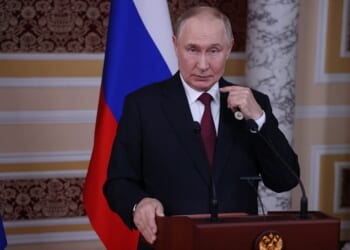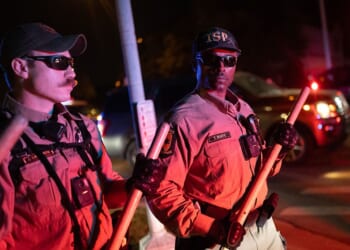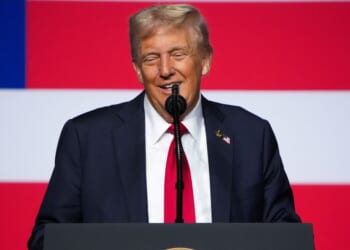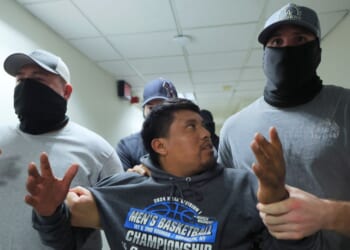Pumped-up soldiers swarmed onto the ramshackle streets, lining up residents on their knees while two helicopters buzzed low over houses. Higher in the hills, where farmers raised weed and opium poppies, troops got into gunfights with cartel operatives. It was 13 December, 2006, and I was in the Michoacán mountain town of Aguililla with a photographer and cameraman from the Associated Press. We were there to follow a mobilisation of the Mexican army against meth and marijuana traffickers from the cartel known as La Familia.
Two days earlier, then-president Felipe Calderón announced the deployment of 6,500 soldiers and federal police in an offensive called Operation Michoacán. The following January, an additional 3,300 troops would carry out Operation Tijuana. It gradually became a national mobilisation with the bulk of the Mexican army along with marines and paramilitary federal police taking on narcos. Soon after, President George W. Bush held talks with Calderón. By 2008, Washington was bankrolling the new Mérida Initiative, a pan-American campaign to take on drug traffickers.
“New pages of glory will be written. I instruct you to persevere until glory is achieved,” Calderón told soldiers in February 2007. “We will give no truce or quarter to the enemies of Mexico.” These were stark martial terms. In another event, Calderón addressed troops wearing an army jacket and cap in a base on Michoacán, unusual attire for a Mexican president.
Over 18 years later, the Mexican army is still on the streets fighting cartels, which have diversified from drugs to a portfolio of rackets including extortion, human smuggling and oil theft. During this time, Mexico has suffered about half a million total homicides (Mexico’s statistics institute counts 486,000 between 2007 and 2024). Cartels and the security forces fighting them, which have also committed massacres, could be responsible for almost two thirds of that number. Cartel sicarios — hitmen — not only wield Kalashnikovs and 50 cals (mostly from the United States), but build home-made fighting vehicles, or “monsters”, armoured drones and improvised landmines. Self-defence militias, or auto defensas, have risen up as a third force, though they can often just be narcos in disguise. With 130,000 people disappeared, and mass graves in cow fields and ranches, mothers join brigades to search for their lost children, while citizens march vainly for peace.
Meanwhile, foreign mercenaries are increasingly involved on the side of the cartels. They have come from various countries, including the United States, but Colombian veterans are especially sought after, with their combat experience and with specialist snipers and drone operators.
And then there’s Trump. He has designated various cartels as foreign terrorist organisations, and US special forces are currently training Mexican soldiers. He has also threatened US attacks on cartel targets in Mexico, and US forces have blown up boats allegedly carrying drugs in the Caribbean and Pacific.
While this bloody mess in Mexico has claimed more victims than some traditional wars, there is still disagreement over how we should understand this conflict, or even name it. This isn’t just an academic debate. Recognising an armed conflict has legal implications for the Mexican government. It’s also bad publicity.
When the International Institute for Strategic Studies in London classified Mexico as the second deadliest armed conflict in the world in 2017, Mexico’s foreign office issued an irate response. “The report irresponsibly points to the existence of an “(non-international) armed conflict” in Mexico,” it said. “This is incorrect.”
But beyond what is politically convenient for Mexico, there are other factors making the Mexican labyrinth tricky to frame. Much of the country appears largely peaceful despite the bloodshed, and even when cartels control territory it’s as a shadow power rather than a full takeover. And as there are comparable problems of organised crime and militarised law enforcement across Latin America, should we also talk about armed conflicts in Brazil, Honduras and now Ecuador?
So how can we understand this period of violence, which I now think is best referred to as the Mexican Cartel Wars? We need to look at when it really began, who the sides involved are, and, to offer some hope, when it may finally end.
I join some other writers in describing the Mexican Cartel Wars as a form of hybrid armed conflict, somewhere between crime and war. This crime war is far less lethal than international conflicts like the Second World War, and nor does it reach the threshold of traditional civil wars, like the Spanish, US or Salvadoran, in terms of intensity or politics. There aren’t two sides with clear leaders and ideologies fighting for dominance of the central state. Yet there is endemic organised violence, which claims thousands of lives per year. As such, it could be compared to periods of violence elsewhere, which, though brutal, did not descend into full-scale civil wars. These include the Colombian conflict, the civil conflict in the Philippines, the Chinese warlord era, the Haitian crisis and, albeit on a smaller scale, the Troubles in Northern Ireland.
The Mexican Cartel Wars involve a plethora of criminal kingpins, death squads and self-defence militias, as well as police, soldiers and marines. All these are entwined with the cartels and fight among themselves. Violence shifts around the country in a series of distinct but interconnected conflicts, with operatives, money and techniques (from beheading to drones) flowing between them.
The Geneva Conventions haven’t caught up with the language and laws for this type of hybrid conflict. I wouldn’t argue that the Mexican government has to treat sicarios like prisoners of war, but it still has to figure out a strategy for peace.
Cartels are at the heart of this conflict, yet they are complex and evolving organisms. Essentially, they are hierarchical networks of paramilitary organised crime. Profits from drugs and a range of rackets drive the violence. Cartels include the biggest mobs, Jalisco and Sinaloa, and powerful regional players, like the Gulf and Northeast cartels, as well as more local but still brutal outfits like the Guerreros Unidos, which we could call cartelitos.
When Calderón launched his offensive in 2006, he was reacting to rising cartel violence, especially in his home state of Michoacán. But fighting between drug traffickers and the involvement of the Mexican army in anti-drug operations go back decades. The first US Customs probe into Mexican opium traffickers was in 1916. The Mexican government mobilised soldiers against poppy growers in Sinaloa in the Forties, and then more seriously in the Seventies in what it called Operation Condor (which was also the name of a CIA op against Leftists across Latin America).
Colombian traffickers were dubbed the Medellín Cartel from about 1980, and the Guadalajara Cartel reached its zenith in 1985 (though, as the academic Carlos Pérez Ricart writes, people didn’t refer to it as that until later). The Tijuana Cartel pioneered narco terror in the Nineties, and army defectors in the Zetas seriously upped the game with paramilitary hit squads in the 2000s, leading to Calderón’s offensive.
Yet the sheer quantity of Mexican troops on the streets, and the severity of cartel violence, reached new heights under Calderón. We could see the period from the Nineties to 2006 as a proto-phase of cartel battles: with the real Mexican Cartel Wars unleashed after the military offensive.
Another detail is that after Calderón kicked off the crackdown, murders in Mexico actually dipped, before going up sharply in 2008 and then exploding in 2010. It’s unfair to blame Calderón entirely for the cartel wars, but he did throw oil onto the fire, as cartels escalated their brutal battle tactics and Mexican soldiers carried out murders themselves. From 2010 onward, Mexico suffered the massacres and mass graves that have characterised the conflict.
A tricky but central question is how many murders are actually related to cartels, as opposed to just bar fights or “passion” killings. The truth is we can’t know for sure: about 90% of homicides are never solved. Yet there are clues.
Calderón created a unit with members of the army, police and Mexico’s intelligence agency (CISEN) to estimate how many deaths were cartel-related. Alejandro Hope, who was then at CISEN, described to me how they looked for signs of cartel activity, from beheadings to the use of grenades and AK-47s. They also included killings confirmed by soldiers.
The count varies by year, but in both 2010 and 2011 cartel-related violence represented close to 60% of all homicides. If you extrapolate that over all homicides since 2006, it would be about 300,000 deaths. That is a colossal figure. Over these last two decades, Mexico has been a genuine bloodbath.
“Over these last two decades, Mexico has been a genuine bloodbath.”
Is there a way to end the Mexican Cartel Wars? One challenge is that it’s not like a regular war where governments or political factions come to the table and hammer out a peace deal. We have also learned that taking out kingpins, like El Chapo and El Mayo, doesn’t stop it. Cartels are many-headed hydra, and when you cut off a head, several more vicious ones grow in its place.
Some have called to send the army back to the barracks. This doesn’t finish the fight either, as cartels keep on battling amongst themselves. Presidents have pulled troops out of various cities only to send them back when violence explodes.
But no conflict goes on forever. About 2010, I heard a CISEN officer make the prediction it would be a 30-year war. There is no exact science to that, but it rings true to me: a full generation of killing before things calm down. Or until the murders go back to the level of 2006, with 10,000 homicides or fewer in a year.
There needs to be a combination of factors to reach this. More effective law enforcement in Mexico is crucial, however that is achieved. Trump’s idea of bombing cartels is certainly a deterrent, though it could put prices up, which encourages others to get in the business. And Trump hasn’t addressed US drug demand; perhaps in the future this will finally go down. Changing demographics in Mexico may be key too: as the birth rate falls, there will be fewer youths to recruit as sicarios. Increased living standards could also reduce the temptation of becoming a cartel killer.
There are other worries though. Back in 1998, Charles Bowden wrote Juárez: The Laboratory of Our Future, illustrating the violence on the US-Mexico border. In retrospect, the title was prescient about the bloodshed that awaited Mexico in the 21st century. But has Mexico over the last two decades itself been a laboratory for a new style of warfare? And if that is the case, could this type of hybrid armed conflict find new environments to nestle in? With organised crime moving easily over borders, economic stagnation and the power of many states eroding, I fear it will.

















